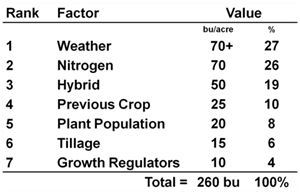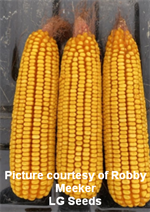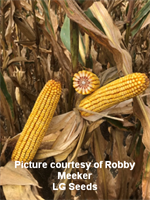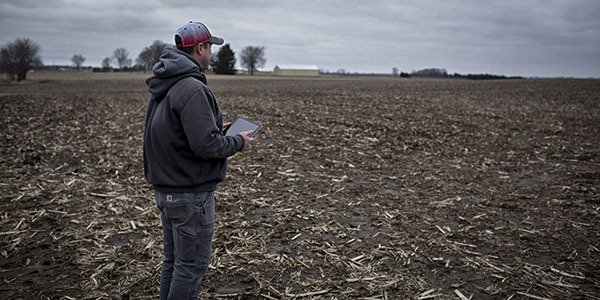AGRONOMICSUPPORT
YOU CAN TAKETO THE FIELD
Level Up: High Yield Corn Management
Planting season will be here before we know it, which is why now is a good time to think about taking steps to raise corn yield levels. While there are many factors that determine corn yield, it’s important to start with the basics. Having fields that are well-drained with good tile is a great place to start on the high yield path. The next item included in the basics is proper fertility. Having your pH in check, as well as your Phosphorus and Potassium levels up to par, are a necessity when you’re working towards maximum corn yields. Last on the list of basics is having healthy soils with limited compaction, allowing for good root structure.
For the rest of our steps of high yield corn management, let’s walk through University of Illinois’ Dr. Fred Below’s 7 Wonders of the Corn Yield World. Below are the seven factors, along with the ranking of each.

First up is Weather, which equates to 27%, and over 70-bushels worth of yield in a 260-bushel yield environment. Tile and irrigation are our main mechanical tools for controlling weather, but they’re not always applicable. Advantage Acre’s® unique ability to use Weather Trends 360® to predict an 11-month forecast is one of the best tools available to help predict the conditions we’ll face in the growing season. Warm soils are the key to success when planting corn. While soybeans need to be planted early for maximum potential - corn is all about establishing a uniform stand with as many plants emerging as possible. We need to look for planting windows with warm soils that will not have a cold saturating rain within 48 hours after planting.
Second on the list is Nitrogen - worth 26% and 70 bushels of yield. There really isn’t a silver bullet when it comes to nitrogen management, but it is important that N is available all season long. Several different methods can be successful to create this availability. It’s also important to remember that a corn plant takes up 75% of its Nitrogen after the V8 growth stage – so late season availability is critical.
Third on the list is selection of the correct hybrid with a score of 50 bushels and 19% of the overall value. With the progression of hybrids, we also know more about management of hybrids than ever before. We also know that the perfect hybrid may not exist – but the perfect mix of hybrids for your farm certainly does exist. When you’re selecting corn hybrids, it is important to go acre-by-acre and field-by-field to get the right product on the right acre. Your LG Seeds team is equipped with extensive hybrid knowledge – as well as expertise about your local conditions – to help you through the product placement process.
 The fourth factor of corn yield is the previous crop, worth 25 bushels and 8% of the overall yield. Previous crop can have a large impact on corn yield. When planting after a legume crop like soybeans, we don’t need as much nitrogen as we do when following corn. It is also important to remember the carbon penalty when following corn. Microbials need nitrogen to break down carbon in the soil, thus tying up the Nitrogen that would otherwise be available to the plant. When planting corn following corn, we need to increase the Nitrogen rate in total N applied, as well as manage which hybrids are chosen. Selecting a product that has good health, good tolerance to Anthracnose and having rootworm control in high rootworm pressure areas is critical in corn-on-corn situations.
The fourth factor of corn yield is the previous crop, worth 25 bushels and 8% of the overall yield. Previous crop can have a large impact on corn yield. When planting after a legume crop like soybeans, we don’t need as much nitrogen as we do when following corn. It is also important to remember the carbon penalty when following corn. Microbials need nitrogen to break down carbon in the soil, thus tying up the Nitrogen that would otherwise be available to the plant. When planting corn following corn, we need to increase the Nitrogen rate in total N applied, as well as manage which hybrids are chosen. Selecting a product that has good health, good tolerance to Anthracnose and having rootworm control in high rootworm pressure areas is critical in corn-on-corn situations.
Planting Population is the fifth factor of seven, worth 20 bushels and 8% of yield. Planting populations need to be hybrid specific, not farm specific. Every hybrid should be managed slightly differently - getting as many ears as possible, without crowding the plants is key to success.
 Tillage - the sixth of the seven factors worth 15 bushels and 6% of yield. Tillage is primarily for residue management. It also allows soils to warm faster in the spring, which will hopefully lead to greater seedling emergence.
Tillage - the sixth of the seven factors worth 15 bushels and 6% of yield. Tillage is primarily for residue management. It also allows soils to warm faster in the spring, which will hopefully lead to greater seedling emergence.
The seventh and final factor, to add up to our total numbers of 260 bushel and 100% of yield, is growth regulators - worth 10 bushel and 4% of yield. Fungicides are important for many growers that are pushing corn yield limits higher and higher every year. While there are certain hybrids that do have a greater response to fungicides, we typically see bigger responses when we have a higher yield potential. It is also important to know what diseases, environments, and fungicides we’re working with. When selecting a fungicide, it’s important to have a preventive and curative action to the fungicide. Timing is also key to success - an application just before brown silk is the most common practice.
While trying to push the corn yield level to new heights, it’s important to try something new on your farm every year. The most detrimental words for a farming operation are “We’ve always done it this way.” Don’t be afraid to try something new and challenge the status quo of average corn yields. As the 2022 season approaches, let our LG Seeds team and our unique hybrids push your farming operation to the next level and break yield barriers that have never been broken.
Download a copy of this technical bulletin here: Level Up: High Yield Corn Management
Sources and additional information: http://cropphysiology.cropsci.illinois.edu/research/seven_wonders.html






Sales Agronomist